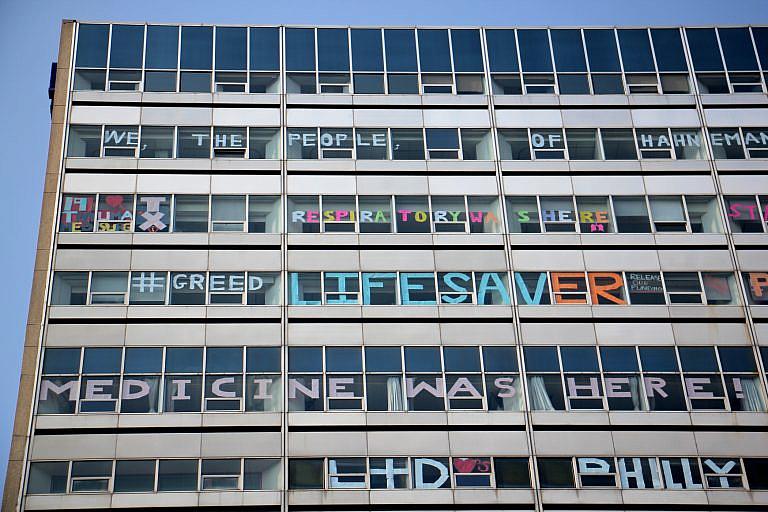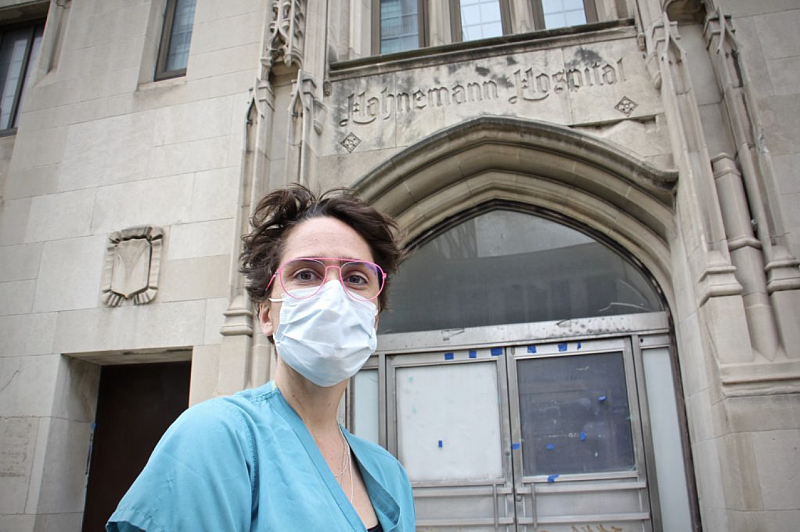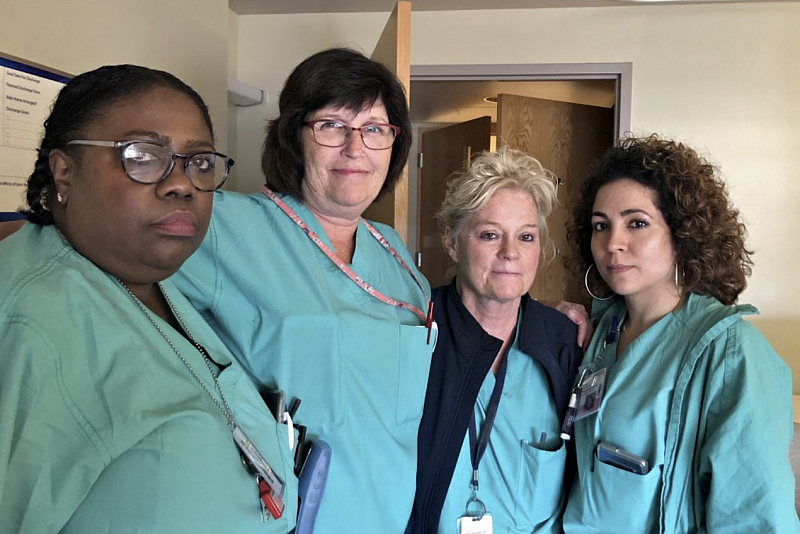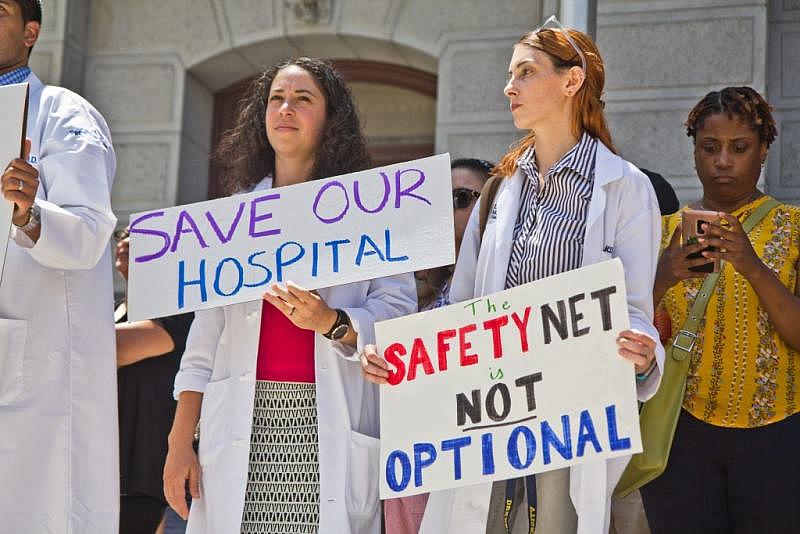How Philadelphia escaped disaster in the face of a dozen shuttered maternity wards
WHYY’s Alan Yu and Nina Feldman reported this story as part of the USC Annenberg Center for Health Journalism’s 2020 Data Fellowship.

Hahnemann Hospital windows are decorated by employees as the hospital prepares to close.
(Emma Lee/WHYY)
This story is from The Pulse, a weekly health and science podcast.
Subscribe on Apple Podcasts, Spotify or wherever you get your podcasts.
Shawn Mattson was used to doing more with less: Working in the labor and delivery unit at Hahnemann University Hospital was like serving in the trenches.
Staff formed bonds and gained experience in the face of a high volume of very sick patients, with limited resources. Doctors and nurses jerry-rigged broken stretchers and overlooked peeling paint. It wasn’t uncommon, said Mattson — a resident on the labor and delivery floor until 2019 — for an overhead light to be out and the proper lamp for a pelvic exam to be missing.
“So you have a headlamp like you’re doing cave diving,” Mattson recalled, laughing. “MacGyvering some situation to make it work.”
In the late spring of 2019, the usual shortages Mattson and her colleagues had gotten used to working around began to feel more dire. Internal fetal monitoring supplies ran out, and were not reordered. The air conditioning stopped working. There were no clean linens in the operating room. There was an overwhelming sense that the writing was on the wall.

And yet the chair of obstetrics and gynecology, Owen Montgomery, assured Mattson and her fellow residents there was no way the hospital could close. It delivered babies for thousands of uninsured and publicly insured patients across Philadelphia, and had since before the Civil War.
There was an infrastructure for high-risk pregnancies built into the fabric of the place that could be found nowhere else in the city. There was a direct pipeline from the city’s health centers, where people got free prenatal care, to Hahnemann’s delivery floor. It was just too important to close — the city would never let that happen.
But the hospital’s owner, California-based investment banker Joel Freedman, had other plans. He was operating a for-profit hospital but losing more than he was bringing in. He had tried to sell the sinking hospital, but couldn’t arrange for a buyer. So he did what any rational business person would: He cut his losses and shut Hahnemann down in 2019.
Mattson felt the ground shake beneath her. She was terrified for her patients.
Many had delivered their babies and had been seeing doctors at Hahnemann for years, and had never received care anywhere else. Most were on Medicaid. Many were uninsured, undocumented immigrants who spoke English as a second language — there were systems in place to get these women emergency medical coverage at Hahnemann.
The midwives there knew that when Southeast Asian women asked for a glass of water while laboring, they usually meant warm water. They knew not to push some people to start breastfeeding before they were ready.
Would these women find that specialized care wherever they were forced to go? Would there even be enough space somewhere else?
“So many tears from so many people,” Mattson recalled. “That’s where all their doctors were — everyone they trusted.”
Mattson was not the first person to have these concerns, because this was not the first time the rug was pulled out from under a labor and delivery unit.
Between 1997 and 2009, 13 maternity wards or hospitals containing labor and delivery units closed in Philadelphia. Most were at small community hospitals that drew patients from the surrounding neighborhoods. By 2009, a city that sees roughly 20,000 births a year had only six hospitals delivering babies.
“The question is: What’s the tipping point?” said Donald Schwartz, who was commissioner of the Philadelphia Department of Public Health at the time. “At what point is it no longer possible for remaining institutions to absorb the need?”
The labor and delivery units that remained — all at large teaching hospitals associated with universities — saw a crisis on the horizon. They worried one more closure would put them over that edge.
So the chiefs of obstetrics at those hospitals did something they had never done before: They set aside the usual competition and worked as a team.
The current impact of Hahnemann Hospital’s closure on the health of babies and families across Philadelphia is not yet fully clear. In the meantime, with the merger of two major city health systems in the offing, some clues can be found in the way things unfolded more than a decade ago.
Back then, medical professionals were also terrified that the closures would result in disaster.
This is the story of why they didn’t.
Deliveries as loss leaders
It was 2009, and Julie Cristol was hanging on by a thread. She had been a midwife for 20 years, and she had never seen so many pregnant patients coming into the labor and delivery unit at Pennsylvania Hospital.
There was no time for the back rubs and extra care she took pride in as part of her work.
“We were just running from room to room,” recalled Cristol, who works now at Lifecycle WomanCare in Bryn Mawr, which provides health care for women regardless of income. “We were just taking care of a lot more people at once.”
That surge meant far more than a dearth of back rubs. There simply wasn’t enough space. People were forced to wait for delivery rooms to open up. Women were delivering on triage floors, or in postpartum rooms, or on stretchers in the hallway. Cristol saw the system bending and bending — she wasn’t sure how much more it could take.
“What I really remember is like, ‘Oh, my gosh, things are relatively safe, but it’s because we’re killing ourselves here to keep it that way.’”

Hospitals have traditionally thought of obstetrics as a “loss leader” — one that doesn’t bring in revenue for the hospital on its own, but can lead to profits if the patient continues to seek other types of care there in the years to come.
That was the model at Philadelphia community hospitals such as Jeanes, Frankford Torresdale, Northeastern, Methodist, and Chestnut Hill, which drew patients from the surrounding neighborhoods.
But Medicaid — the federally funded, state-administered health insurance for people under a certain income threshold — reimburses hospitals at a much lower rate for delivery than private insurance does — in fact, some research shows that commercial insurance pays hospitals twice as much as Medicaid for childbirth. (Even if someone is not enrolled in Medicaid, that person automatically becomes eligible for it during pregnancy, with the exception of those who don’t qualify for public benefits, such as undocumented immigrants.)
Because of those low payments, the higher the share of patients on Medicaid or without insurance, the harder it is for a hospital to balance its budget. That’s why hospitals are always trying to achieve what is known as a good “payer mix,” meaning a large enough proportion of patients with private insurance to effectively subsidize those insured by Medicaid and Medicare.
The community hospitals were often situated in areas of Philadelphia that didn’t draw a diverse payer mix, meaning there wasn’t much private insurance to fuel their operations.
Still, revenue was only one-half of the equation. The other financial force at play was the cost of providing the care. And one of the most expensive aspects of obstetrics that hospitals absorb is the price of risk.
Medical malpractice rates are already higher for obstetricians than for any other specialty, and in the late 1990s, the rates in Pennsylvania were higher than in all but a handful of states. Within the commonwealth, Philadelphia had the highest rates of all.
Though large teaching hospitals could buy liability insurance for their doctors in big bundles, the smaller community hospitals suffered — the costs simply outweighed the revenue.
Given the high costs and low revenue, it simply didn’t make as much financial sense for the smaller community hospitals to keep offering deliveries when they could make more money converting their maternity units to something more lucrative, like cancer or cardiac care.
That’s exactly what happened at Episcopal Hospital in Kensington, Mercy in West Philadelphia, Chestnut Hill, and Methodist in South Philadelphia, which all closed maternity wards between 2002 and 2009. Some hospitals, like City Avenue Hospital and Parkview Hospital, closed altogether. They all cited the high cost of malpractice insurance as part of or the main reason why the hospitals or maternity wards had to close.
”We had been subsidizing the program because we had the resources,” Gavin Kerr, chief executive of the Mercy Health System in 2002, told the New York Times back then. “But as the malpractice premiums increased, that dramatically shrunk the resources.”
David Fikse, the CEO of Parkview Hospital in 2003, told the Philadelphia Business Journal back then that “the medical malpractice insurance crisis, the payor market, the state budget cuts and rising operational and technological costs have made it impossible for a community hospital like Parkview to survive.”
The remaining institutions were likely not breaking even on births either, but the financial backing of the universities they were associated with worked as a safety net.
The hospitals associated with medical schools also had the advantage of being classrooms for obstetricians in training.
“The basic equation was if you were committed to education — if you’re educating the next generation of health care providers — then the university or the medical school was willing to lose money providing obstetrical care,” said Owen Montgomery, who is now a professor of obstetrics and gynecology at Thomas Jefferson University but headed Hahnemann’s labor and delivery unit when it closed. The federal money that goes to pay medical residents can also end up subsidizing much of obstetrical care, since residents’ salaries aren’t paid in full by hospitals.
Teamwork makes the dream work
When Temple University decided to close Northeastern Hospital in 2009, it was the final straw. The chair of obstetrics and gynecology at Northeastern, Enrique Hernandez, reached out to his counterparts at the remaining hospitals around the city to see if there was anything they could do for the predominantly uninsured and Spanish-speaking population that usually gave birth there.
“There were literally women who were scheduled to have cesarean sections after the hospital closed,” recalled Montgomery.
It is customary for labor and delivery units to run at about 75% occupancy, to account for surges. After the wave of closures, they were running at about 92%. That meant any surge tipped the units over capacity.
The remaining hospitals were feeling the pressure of the increased volume, and in Philadelphia, things were getting worse. Infant mortality rates were climbing in the city as the maternity wards shuttered.
So, instead of functioning as independent operators as they always had, Montgomery and the heads of the remaining obstetrics units heeded Hernandez’s call. Considering the crisis was now a matter of public health and safety, they got together with then-Philadelphia Health Commissioner Donald Schwartz and made a plan for coordinated maternal care in Philadelphia.
“With the closures, we were really pushed to think differently,” said Jack Ludmir, who was chair of obstetrics at Pennsylvania Hospital at the time. “We are able to sit together, no longer in the spirit of competition, but in the spirit of collaboration.”
Though working together may seem intuitive, it’s actually quite rare. Normally, hospitals compete with one another for patients.
Hospitals rely on referrals from clinical practices across the region for a flow of patients, often privately insured, with whom they build relationships. They don’t want to turn those patients away, because they provide a steady stream of people to care for, said Ludmir — once in the door, so to speak, those patients might stay with the hospital for future treatment.
But with the risk too great of any one labor unit being inundated, the hospitals began keeping tabs on the census at all the units and passed patients along to other wards as needed.
“From Jefferson or from Hahnemann or from Temple, if there was a need, they would just feel free to say, ‘Listen Ludmir, we have this patient and we cannot take care of her — can you please take care of her?’ And vice versa,” recalled Ludmir. “We put aside the referral patterns in order to take care of our own city.”
Many of the new patients the remaining hospitals took on were Medicaid patients. Ludmir attributed that to privately insured patients shifting from the community hospitals to finding care in the suburbs surrounding Philadelphia. The ones who remained couldn’t afford to leave.
“Patients that are affluent, or have good insurance, they have their own transportation, they can do it,” he said. “Very different to our vulnerable patients … these are patients that cannot go anywhere.”
Though the increased share of Medicaid patients may have placed greater financial strain on the hospitals, their teamwork helped them brace for it.
The consortium shared best practices, the latest evidence-based research, and risk-mitigation strategies. It worked to establish a common electronic medical record that could be easily transferred between hospitals.
It also changed the way obstetricians work: previously, one doctor would be assigned a caseload of patients, and attend to all of their needs: inpatient care, office visits, surgeries, and deliveries. Now, under a new “laborist” model, there are doctors assigned to be on the labor and delivery floors at all times just to take care of people delivering babies.
Perhaps most importantly, the hospitals triaged patients according to their specific needs, and transferred them when one of their wards was starting to get too full, avoiding an overflow of patients that could lead to another closure, which would in turn force them all to buckle under the volume of more patients.
“What collaboration meant was nobody was going to have a terrible onslaught on patients because somebody closed suddenly, which is a really bad thing,” recalled Schwartz.
Some of the hospitals expanded too, to be able to accommodate more patients.
To handle the strain, Einstein Medical Center spent $10 million on a series of renovations over the course of about a year around 2006. The hospital closed a pediatric unit and transformed it into a postpartum unit. It built a post-operative room for patients who had undergone C-sections, freeing up room for patients in labor. It transformed office space to a triage unit with antenatal testing, including ultrasound rooms. Einstein explained to Philadelphia Business Journal that the expansion was part of serving the community, and maintaining their residency program for medical students.
The hospitals’ efforts appeared to work. After a temporary rise, infant mortality rates in Philadelphia started to drop back down to where they were in the 1990s, before the wave of obstetrical unit closures.
An unexpected silver lining
By some measures, the crucible created by the loss of maternity wards may have led to better care at the remaining hospitals.
Aasta Mehta is the medical officer of women’s health for the Philadelphia Department of Public Health. As part of her job, she reviews deaths related to childbirth.
“There are some deaths that I reviewed at the state level where if this person was in Philadelphia, they would not have died,” said Mehta, who is also an OB/GYN with Penn Medicine.
Because the remaining maternity wards in the city had to stay up on the best evidence and share best practices, they all improved, Mehta said.
Ellen Wolf saw that in action. A labor and delivery nurse, Wolf worked at several maternity wards that shuttered before landing at Hahnemann in time for its closure.
At Chestnut Hill Hospital, Wolf said, obstetricians were more conservative in their practices than at the larger institutions with midwifery practices, in part because they didn’t have a medical school as incentive to keep up with the latest research and evidence-based practices.
“Their thought processes were kind of like, ‘I’ve done this, I’ve been a doctor for 40 years, and this is what I’ve done and this is what’s worked and by golly, I’m going to keep doing it this way,’” Wolf said.
She offered as an example the prevalence of episiotomies — the practice of snipping the perineum if it appears the mother may not be dilating enough to deliver the baby.
“The woman would be pushing, and the baby would be just about crowning — in about 35 seconds, the baby was going to be out,” Wolf said. “And every single time, [the obstetrician] cut an episiotomy. That’s like very conservative, very old-fashioned, very like 1950s medical judgment. I would cringe.”
Though the procedure is sometimes necessary, it lengthens recovery time and can affect a woman’s physiology going forward. The American College of Obstetrics and Gynecology first advised against the routine use of episiotomies in 2006.
In addition to staying on top of such recommendations, the maternity wards in larger hospitals can manage emergencies more effectively. Hemorrhage deaths, one of the leading causes of maternal mortality directly related to pregnancy in the United States, are almost minimal in Philadelphia now.
“I do think that that’s because of the fact that the remaining delivery hospitals all are well equipped to manage these kinds of high-risk conditions,” said Mehta.
A surprising financial stability may have come with increased volume as well.
Though the remaining teaching hospitals saw a dramatic increase in Medicaid patients whose care was poorly reimbursed, that also corresponded with a higher volume of patients whose infants needed special care. The percentage of babies born who were admitted to neonatal intensive care units (NICUs) nearly doubled from 2005 to its peak in 2011. In contrast with standard deliveries, care at NICUs is reimbursed at higher margins, even for Medicaid patients.
“When you are a large institution with a very large volume, including higher-risk patients, then you also can offset the losses that come with a regular old, garden-variety, low-risk vaginal birth,” said Katy Backes Kozhimannil, a researcher and professor of public health at the University of Minnesota.
In the long run, many believe the wave of maternity unit closures at community hospitals in Philadelphia has improved care.
“If you were to ask me: Do I think it was a good thing that these obstetrical units closed or a bad thing? I would tell you that it was a good thing,” said Arnold Cohen, chair of obstetrics and gynecology at Einstein Medical Center Montgomery and a veteran OB/GYN who has been practicing for more than three decades.
Doing better than, ‘Did you die?’
While metrics such as infant mortality are certainly important, experts say they’re not the absolute baseline of what should be considered a successful pregnancy.
“Frankly, we should be doing better with birth than, “Did you die?”’ said Backes Kozhimannil. “Not dying is not the same thing as having a great outcome.”
Research has shown that lack of access to maternity care and the complications that come with it — such as not knowing the team of people who will be caring for you during your delivery, as well as open questions about how you’ll get to the hospital, the labor process, and other logistical factors — can result in higher stress levels. Stress during pregnancy has been linked to adverse birth outcomes like more infectious disease in infants.
And maternity wards do more than just deliver babies.
Then-city Health Commissioner Schwartz recognized that the absence of the community hospitals would mean neighborhoods like South Philly, the far Southwest and the Northeast would go without prenatal care, which is critical in identifying chronic health conditions early on in a pregnancy, such as high blood pressure and diabetes, to avoid complications later on.
In 2007, only 3% of pregnant women in Philadelphia received no prenatal care before delivery. That rate had doubled by 2009.
So Schwartz worked to strengthen the prenatal care services at the city’s eight community health centers by deploying midwives there who would establish relationships with mothers early on in their pregnancies and continue all the way through delivery. He increased the interpretation options offered in South Philadelphia, which had become a diverse community where many spoke Spanish and a range of Southeast Asian languages.
Even so, the percentage of births in which there was no prenatal care has continued to climb in Philadelphia since 2000.
Still, the bottom never fell out the way everyone had expected it to. Not for a decade.
Hahnemann as a tipping point?
When Hahnemann Hospital shut its doors, in some ways the pact between obstetrics chiefs was broken. Labor and delivery staff were transported back to 2009 all over again: Would this be the straw that broke the camel’s back?
Laniece Coleman was head of midwifery at Hahnemann when it closed in 2019.
“To have to scramble at the last minute and make that system work felt very unsafe,” Coleman said.
Giving birth is not a procedure like having knee surgery or getting a root canal. It’s emotional, and people spend months planning for it.
“You have this view in your head of what your birth is going to be like, and certainly feeling safe is a very important part of the labor and birth process,” Coleman said.
“Going somewhere new was very scary for them.”
Coleman remembered one woman who’d had two children at Hahnemann, just as three generations of women in her family had before her. She vowed to go back whether the hospital was closed or not.
“We worked through it, but it was just a loss of a dream for her,” Coleman recalled, noting that the woman delivered her baby elsewhere without any issues. “It was a tradition. When that was taken away at the end of her pregnancy, she grieved.”

Shawn Mattson — who did her residency at Hahnemann — now works at Jefferson as an OB/GYN. She said it is still common for patients to show up without their medical records, or without having received any prenatal care there, meaning the nurses and midwives don’t have any background information on them. And patients still bring up Hahnemann all the time, unprompted, Mattson said.
Just weeks after Hahnemann closed, nearby Jefferson Health offered admitting privileges to the doctors and midwives there, and the queue of pregnant patients was shifted over to Jefferson. Eventually, Jefferson offered jobs to Mattson and Coleman and Montgomery and most of Hahnemann’s labor and delivery staff, and began to develop the systems that had been in place at Hahnemann for the immigrant patients, the patients with chronic conditions, and the uninsured patients that had transferred from one hospital to the other.
The delicate balance that the heads of obstetrics had established a decade prior appeared to be staying stable in the face of one more closure. The dam was holding, for now.
But if the coronavirus pandemic has revealed anything about the business of health care, it’s that hospitals are vulnerable to financial pressures.
Across the country, sales and closures loom — and in Philadelphia, two of the giant teaching hospitals that remain are about to merge. Those involved with Jefferson Health’s merger with the Einstein Healthcare Network say it is unlikely a maternity ward will be lost in the process. But that has happened before.
Maternity care in Philadelphia was saved by a small group of dedicated medical professionals who were committed to providing safe, accessible care and who could afford not to think about how much it would put them under. They trusted that by working together, they would all benefit. Plus, they just liked one another.
“There just happens to be really strong leadership at these institutions that value the collegiality and the collaborative nature that they fostered over the last decade or so,” said Aasta Mehta, who works with the city’s Department of Public Health.
But there are reasons to be skeptical of relying on this kind of coordination, said Mark Pauly, professor of health care management, business economics, and public policy at the University of Pennsylvania’s Wharton School.
“Relying on the good will — and, God bless them, I think they have a lot of good will — of nonprofit hospitals to do this correctly is a little bit risky,” Pauly said. “Some external supervision or external support for coordination would seem to be a good idea.”
Hahnemann employees, city officials, and unions rally against the closing of the hospital. (Kimberly Paynter/WHYY)
However, he added that even coordination among well-intentioned hospital leaders does not address the fundamental problem: that providing good obstetrical care does not pay well enough to cover its costs.
Pauly said that could change if political leaders decide that taking care of people who are pregnant is important enough to, for one thing, increase the Medicaid reimbursement rates, which he described as “stingy.”
“It’s the right thing to do, if we really are as concerned about poor people as nowadays everybody says they are,” Pauly said.
Owen Montgomery — who headed Hahnemann’s labor and delivery unit, and now teaches at Thomas Jefferson University — agreed.
“The state has to decide, or the federal government has to decide, that the care of women delivering the babies … the next citizens of our country, that their care is worth providing at a level which allows the care providers to stay in business,” Montgomery said. “Some of it’s just dollars and cents.”
As it stands, it’s left up to the individual hospitals. And at any minute, they could change their minds.
WHYY’s Alan Yu and Nina Feldman reported this story as part of the USC Annenberg Center for Health Journalism’s 2020 Data Fellowship.
[This story was originally published by WHYY].
Did you like this story? Your support means a lot! Your tax-deductible donation will advance our mission of supporting journalism as a catalyst for change.


